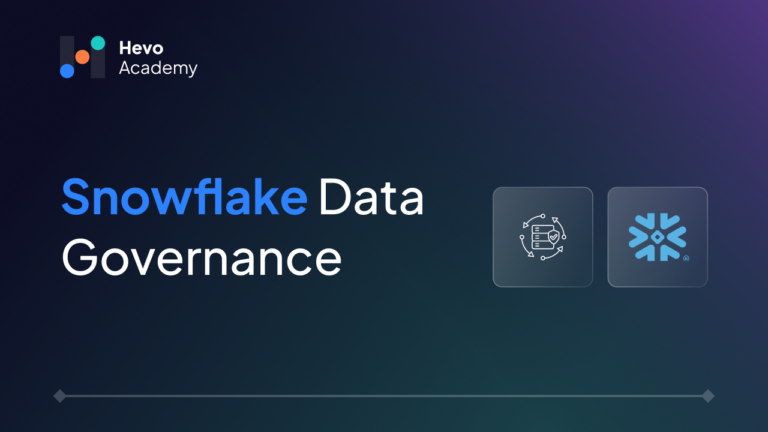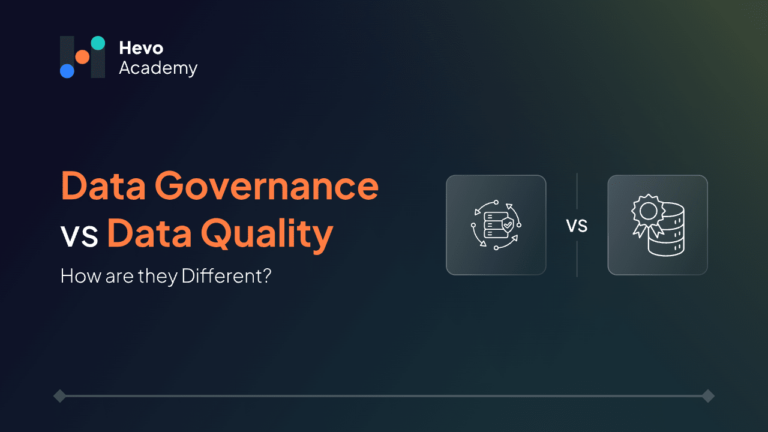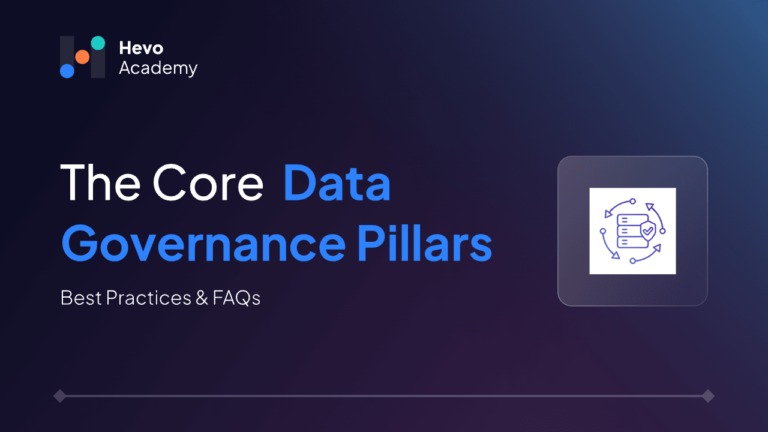In today’s data-driven world, businesses face challenges in managing large volumes of information while complying with regulations like GDPR and CCPA. Snowflake, a cloud-based data platform, excels in storing, processing, and analyzing data, and also offers robust tools for secure data management and governance tailored to business needs. This guide provides an in-depth look at Snowflake data governance capabilities, best practices for data management, and potential implementation challenges, empowering organizations to harness their data effectively.
Table of Contents
Data Governance Overview
What is Data Governance?
Data governance is the overall responsibility for ensuring data is available, accessible, reliable, timely, and secure to support organizational operations. It involves establishing guidelines, duties, and procedures for handling, protecting, and managing data. In essence, data governance maintains data accuracy, validity, and security while ensuring compliance with rules and regulations. It provides clear guidelines for managing data from collection to storage or disposal, encompassing activities like data stewardship, quality, security, and regulatory compliance.
Benefits of Data Governance
Having a robust data governance framework in place brings a wide range of benefits to an organization, including:
- Improved Data Quality: Data governance helps maintain data integrity and standardization of data across the organization to enhance organizational decision making and organizational performance.
- Regulatory Compliance: Governance ensures that organizations meet data protection laws like GDPR, CCPA, HIPAA among others to avoid penalties and legal complications.
- Risk Mitigation: Data governance also plays a part in minimizing data breaches and other cybersecurity threats through data security and proper access control.
- Operational Efficiency: Governance makes the handling of data easier by eliminating unnecessary and duplicate activities that are normally present in an organization while at the same time offering a framework on how the data should be processed.
- Better Decision-Making: Organized, neat, and safeguarded data is beneficial for the company to make the right decisions with the help of accurate information.
- Enhanced Collaboration: Data governance ensures that different teams get the right data in the right format and usage rules hence improving collaboration between the teams.
Looking for seamless data integration with governance features? Try Hevo, the no-code data pipeline platform that ensures secure, real-time data flow.
- No-code data pipeline allows users to manage workflows without technical expertise.
- 150 + pre-built connectors to build your data pipeline in minutes.
- End-to-End Data Encryption for secure data transfers and compliance with regulations.
Hevo automates your data governance effortlessly!
Data Warehouse Governance Best Practices
In a data warehouse environment, data governance is the set of policies and methodologies that help maintain data consistency, security and utility in an organization. Here are some key best practices:
- Define Clear Roles and Responsibilities: Appoint data stewards or custodians to oversee data governance processes and engage stakeholders to ensure policy implementation. This ensures accountability and clear ownership.
- Create a Data Catalog: Develop a data catalog to provide users with information on available data, its location, and usage guidelines. This encourages self-service data usage while adhering to governance policies.
- Automate Data Quality Checks: Implement automated tools to perform regular data quality checks, alerting users to issues and ensuring data accuracy.
- Set Access Control Policies: Secure data at rest and in motion through encryption and regular security checks, ensuring compliance with data security policies.
- Ensure Data Security: Secure data at rest and in motion through encryption and regular security checks, ensuring compliance with data security policies.
- Enable Data Lineage: Track data transformations and movements to ensure data origin, transformation process, and usage are transparent, enhancing data credibility.
- Monitor and Audit Data Usage: Enforce mechanisms to track data usage, including access, modification, and deletion, to identify governance issues and ensure compliance with policies.
What is Snowflake Data Governance?
Snowflake is a cloud-based data warehousing platform that offers scalable, flexible, and user-friendly solutions for managing petabytes of data. Snowflake’s data governance capabilities are built-in, enabling businesses to safeguard their data, maintain compliance with security policies, and meet regulatory standards. These native governance features and tools ensure that data is properly managed and protected, aligning with organizational policies and industry regulations.
Key components of Snowflake’s data governance include:
- Data Access Controls: Snowflake has several measures of access control; it has role-based controls and also has the ability to control access at the object level.
- Data Auditing and Monitoring: Snowflake helps to track the access of data and activity logs meaning that businesses can see how data is being used in real-time.
- Data Masking and Encryption: It is possible to protect sensitive data by employing dynamic data masking and the use of encryption hence restricting the view of specific data fields to only authorized personnel.
- Metadata Management: Snowflake offers data management features that help organizations capture all metadata about data including where it came from and how it is being used.
Snowflake Data Governance Capabilities
1. Data Quality Monitoring and Data Metric Functions
Snowflake offers robust data quality monitoring capabilities, enabling organizations to track and control data quality. Using data metric functions, teams can create checks to ensure data meets required standards, including rule-based validation, detection of missing or out-of-range values, and alerts for data quality issues. Additionally, Snowflake integrates with other data quality tools for enhanced monitoring and maintenance.
2. Column-Level Security
In Snowflake, the column-level security enables organizations to implement row-level access to particular columns in a table. For instance, if there is a table with the data such as SSNs or credit card numbers, the column-level security restricts access to the data to authorized personnel only. This feature is particularly helpful in safeguarding Personally Identifiable Information (PII) and the data privacy laws.
3. Row-Level Security
Snowflake has row-level security (RLS) that enables organizations to limit the access of particular rows of data depending on the user’s characteristics. For instance, a user may only be restricted to access data of a particular region or department. This dynamic filtering assist in making certain that users are only able to view data that they are allowed to and should not be able to view other data that they are not supposed to be viewing.
4. Object Tagging
Object tagging is a feature that has been developed in Snowflake and it enables users to tag their database objects such as tables, views, columns, etc. with certain tags that they want. This capability helps in improving data accessibility, categorization as well as protection. Tags can be used to identify data ownership and sensitivity, and many other parameters that are necessary to meet the requirements of the governance policy.
5. Data Classification
Data classification in Snowflake is a process of sorting the data according to the level of risk it poses to the organization. Similarly, Snowflake enables users to categorize data into different categories such as public, confidential, restricted, among others through tagging and other metadata features. This assist in the implementation of adequate security measures and access control mechanisms depending on the classification level to meet organizational policies and regulations.
6. Tag-Based Masking Policies
The dynamic data masking in Snowflake also supports the tag-based masking policies that enable the masking of fields with sensitive data based on the object tags. For instance, if a specific column has been marked as a PII, a dynamic masking policy can be set to the column to limit the visibility of the entire content to the end-users. This assists in protection of the data from any unauthorized access while at the same time allowing the data to be shared safely.
7. Access History
Snowflake’s access history feature gives information on how the data is being used and who is using it. Users of the organizations can also get to see audit logs that show the interaction that has been made with the data such as the queries run, the objects that have been accessed and the roles of the users involved in the interaction. For compliance audit, security investigations and for ascertaining that the business is following governance policies, access history is very important.
Challenges of Implementing Data Governance in Snowflake
On the one hand, Snowflake offers numerous governance capabilities; on the other hand, the implementation of the data governance framework in Snowflake has its difficulties. Here are some common obstacles organizations may face:Here are some common obstacles organizations may face:
Metadata Scope Limitations
While there are multiple metadata management features in Snowflake, the amount of metadata that can be seen within Snowflake can be quite restricted, especially when it comes to more complicated environments with multiple data sources. Some organizations may need to track metadata more granularly, for example, to track the lineage of all metadata or integrate with other metadata management tools to meet an organization’s governance strategy.
Governance Management for Non-Technical/Business Users
Data governance is typically a cross-functional effort that requires inputs from IT, data stewards and business users. It can be said that Snowflake’s governance features are quite robust and complex for non-technical or business users. In order to eliminate this issue, organizations should ensure that they provide adequate training, documentation and implement easy to use data catalog solutions that can effectively translate between technical and business users.
Governance for Data from Multiple Sources (Non-Snowflake)
Most organizations are running in a hybrid environment, or a multi-cloud environment, and data is not only stored in Snowflake. It can be complex to introduce a single data governance structure that will be applicable to both Snowflake and other sources of data. This means that there is a need to have strong integration and data orchestration practices in order to maintain consistency in the governance policies, access controls and data quality checks across the various environments.
Conclusion
Effective data governance is crucial in today’s environment, and Snowflake offers extensive features to address security, compliance, and quality issues. Its features include column and row-level security, data masking, object tagging, and access history, enabling businesses to protect sensitive information and comply with data protection laws. However, when adopting an integrated data governance approach on Snowflake, organizations should consider limitations such as metadata, non-technical user governance, and multi-source data. With the right strategy, tools, and best practices, Snowflake can be a powerful platform for secure, governed, and trusted data management.
Try Hevo for no-code, zero-maintenance data integration, and keep your data teams up to date. Sign up for a 14-day free trial today.
FAQs
1. Is Snowflake a data management tool?
Snowflake is an advanced cloud computing technology that is used for data storage, data processing, and data analysis. As it offers the tools for data governance and security, it is a data warehousing software at its core.
2. Is Snowflake GDPR compliant?
Indeed, Snowflake has been developed to assist organizations to implement GDPR since it provides encryption of data, dynamic data masking and access control that protects the data.
3. What are Snowflake data principles?
Snowflake’s data principles include the accessibility of data, its scalability, security, and governance, which allow organizations to handle the data accordingly and be compliant with the set regulations.





